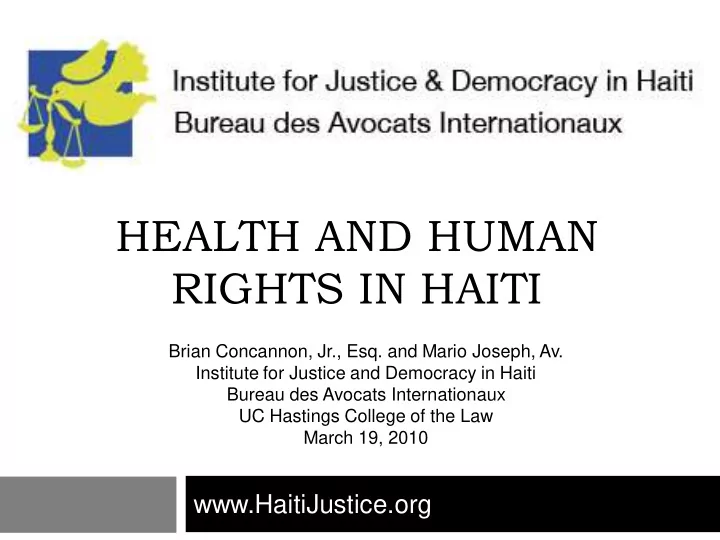

HEALTH AND HUMAN RIGHTS IN HAITI Brian Concannon, Jr., Esq. and Mario Joseph, Av. Institute for Justice and Democracy in Haiti Bureau des Avocats Internationaux UC Hastings College of the Law March 19, 2010 www.HaitiJustice.org
Who We Are…
IJDH and BAI: Seeking Justice for Haiti’s Poor Fight for the rights of Haiti’s poor majority Represent victims of injustice Earthquake victims The unjustly imprisoned Children without access to education
IJDH/BAI: Seeking Justice for Haiti’s Poor Our Approach Our Projects Heath and Human Rights Victim-centered in Prisons Project (HHRPP) Rights-based Human Right to Education Multi-faceted Project (HREP) Haiti Asylum Information Project (HAIP) Half Hour for Haiti Lawyers Earthquake Response Network (LERN)
Our Team: Seamless Advocacy Inside and Outside of Haiti Bureau de Avocats Institute for Justice and Internationaux Democracy in Haiti Support for litigation Litigation in Haiti in Haiti Support for International litigation international litigation Information Information gathering dissemination Grassroots advocacy Grassroots advocacy in Haiti in the U.S. Capacity building Fundraising
Building Haiti Back More Justly A Rights-Based Response to the Earthquake
The Haiti Earthquake “In terms of its proportionate impact on one country, the Haitian earthquake may well be the worst natural disaster ever .” -Bekele Geleta, Secretary General of the International Federation of the Red Cross
Disproportionate Burden on Haiti’s Poor Urban Slums: Home to Haiti’s National Palace: Poor Majority 2 people died in the collapse Tens of thousands of people of the National Palace. died in the collapse of hillside slums.
Inadequate Housing 86% of the urban population in Haiti live in slums. Only 22% of the urban population in Latin America & Caribbean live in Typical Haitian housing: Many houses are made of anything that can provide slums the semblance of shelter, including rags, plastic bags, and banana leaves. PHOTO CREDIT: Peter Hallward, 2007
Structural Causes of the Vulnerability of Haiti’s Poor Subsidized Unjust Rice Trade Laws Degradation of the Environment Migration to the cities Undermining of Haiti’s Overcrowded, unsafe housing Agricultural System Increased vulnerability to natural disaster
Comparing the Earthquakes in Chile and Haiti Although the Earthquake Mortality Chile 500 earthquake Earthquake Intensity was 500 500 450 times 400 stronger 350 than the 230 300 Haiti 250 earthquake, 200 Haiti 150 1 100 1 suffered 230 50 times more 0 mortality. CHILE HAITI
Basic Health Indicators in Haiti 120 100 80 60 40 Haiti 20 0 Latin America and the Carribbean Source: Pan American Health Organization (PAHO), Health Situation in the Americas: Basic Indicators 2005.
Conditions 2 Months Later 1.3 million people were left homeless by the earthquake Today, only 300,000 (less than one third) of those have received “some form of emergency shelter materials” from the International Red Cross Federation. Source: "More Quake Victims in Haiti Getting Shelter" by Lisa Schlein, 3/16/2010
Flooding in Les Cayes after torrential rains on March 1, 2010 “When the rainy season starts, it’s not that people will get wet, but that they will get washed away.” – Alberto Wilde, Cooperative Housing Foundation The rainy season will bring with it increased disease burden and suffering for the hundreds of thousands of Haitians still without shelter. Source: "Rain pours fresh misery on quake-struck Haiti," Rueters, February 11, 2010
Less than 1 Cent per Dollar Dominican Republic 0.5% “The U.S. Haitian Government <1% Haitian Survivors 5% government money is part of close to $2 billion in relief aid flowing Food/Food Transport 18% into Haiti - almost all of it Disaster Relief 42% managed by organizations other than the Haitian U.S. Military Aid: 33% government” U.S. Earthquake Aid to Haiti Source: "Haiti govt gets 1 penny of US quake aid dollar" By Yesica Fisch and Martha Mendoza (AP) January 27, 2010
Earthquake Aid from the American Red Cross Health and family Livelihoods: 4% services: 8% The American Red Cross has raised over $350 Food, million dollars water, Shelter: Allocated or for Haiti relief 38% spent:$106.4 earthquake supplies: million (30%) relief, but less 55% than one third of that has actually been Unallocated: spent or even $247.6 allocated for million (70%) relief efforts. Source: American Red Cross Issues 2 Month Progress Report for Haiti, March 12, 2010
The Lawyers’ Earthquake Response Network (LERN) Connecting U.S. and Haitian lawyers to advance a rights-based response to the earthquake.
What is LERN? Network of 329 lawyers in the U.S. working with Haitian lawyers and grassroots groups to implement a legal response to the earthquake. Employs a human rights-based approach Advocates for earthquake victims, especially displaced persons, women, and children. Works to enforce housing, labor, environmental, and immigration rights. Works to reduce Haiti’s vulnerability to future natural, political, and economic disasters.
Structure and Organization of LERN IJDH and CCR Oversight Committee BAI Network of 329 U.S. Lawyers, Law Students, and Haitian Haitian Law Grassroots Lawyers Professors Groups Project Leaders Disability Earthquake Environmental Housing Immigration Gender Rights Rights Response Rights Rights Opportunities
LERN Across the Globe 7 Organizations 329 Lawyers, Law students, and Law Professors 69 Cities 10 Project Leaders 6 Projects U.S. Based Organization Haiti Based Organization Project Leader LERN Member
LERN: Connecting U.S. Lawyers with the Haitian Grassroots .
LERN in Action Haitian students interview earthquake victims, collecting data on living conditions in the camps.
BAI Earthquake Response Empowering grassroots groups to advocate for themselves. Grassroots women attend training at the BAI to conduct needs assessment of their neighborhoods for advocacy.
Mass Funeral at Titanyen The BAI and the Aristide Foundation organized a funeral ceremony at a mass grave site near Titanyen to honor the children lost in the January 12, 2010 earthquake.
Medical Clinic at the BAI Following the earthquake, the BAI hosted a medical clinic in its courtyard and opened its doors injured earthquake victims.
Media Advocacy The New Media Advocacy Project (NMap) returns to Haiti to film after the earthquake. The BAI’s Mario Joseph is interviewed IJDH Director Brian by Democracy Concannon, Jr.’s opinion piece Now! on “The Help That Haiti Needs” is published in the New York Times blog “Room for Debate.”
Recommend
More recommend